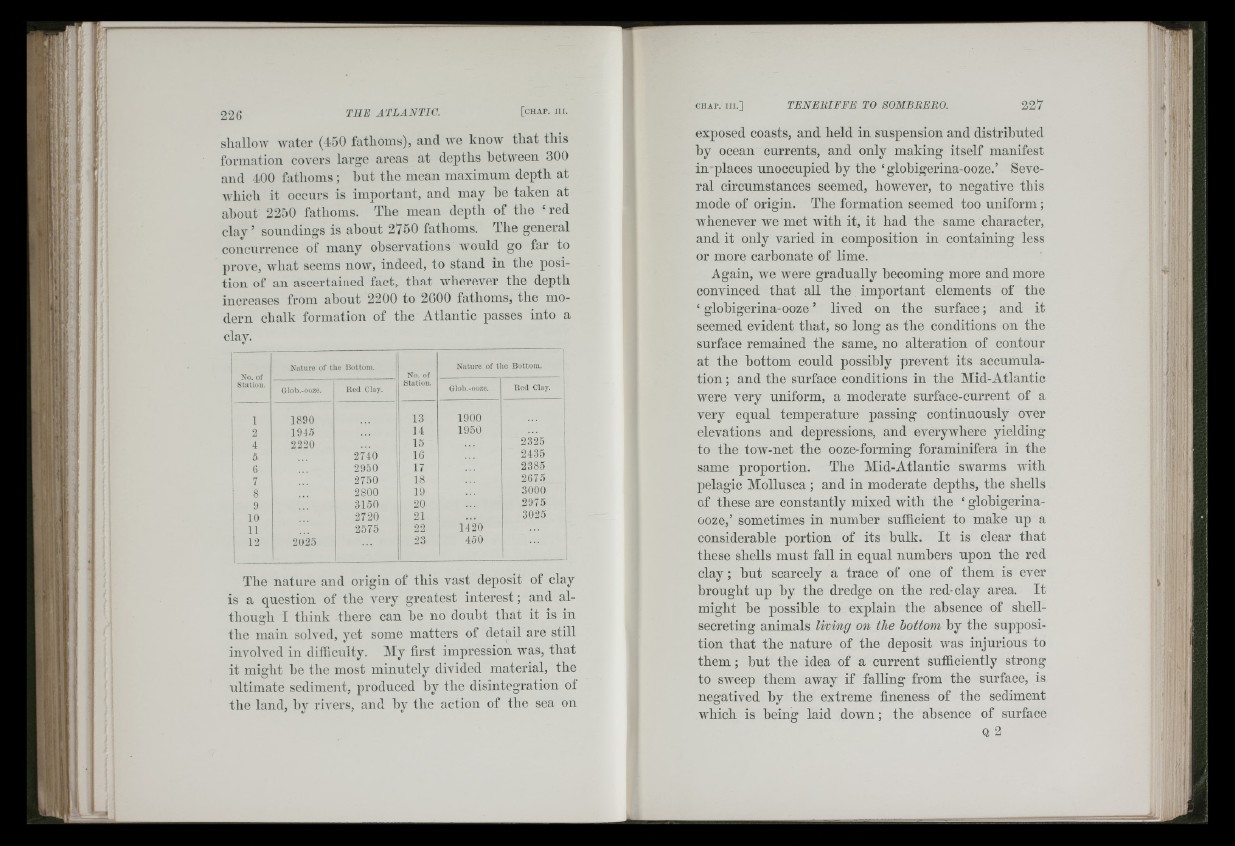
;î . 'i
I I
r
; ?
shallow Avater (450 fathoms), and aa'g knoAV that this
formation covers large areas at depths hetAveen 300
and 400 fathoms; hut the mean maximum depth at
Avhich it occurs is important, and may he taken at
ahout 2250 fathoms. The mean depth of the ‘ red
clay’ soundings is ahout 2750 fathoms. The general
concurrence of many ohservations Avould go far to
proA'e, Avhat seems u o a v , indeed, to stand in the position
of an ascertained fact, that Avherever the depth
increases from ahout 2200 to 2000 fathoms, the modern
chalk formation of the Atlantic passes iuto a
clav.
Xo. of
■ Station.
1
Nature of tlie Bottom. '
No. ot
Station.
Nature of th e Bottom.
Glob.-ooze. Ked Clay. Glob. -ooze. Red Clay.
1 1890 13 1900
2 1945 44 1950
4 2220 15 2325
5 2740 IG 2435
G 2950 : 17 2385
7 2750 i 18 2675
8 2800 19 3000
9 3150 1 20 2975
i 10 2720 I 21 3025
: 11 2575 22 1420
' 1:2 2025 23 450
The nature aud origin of this vast deposit of clay
is a question of the very greatest interest ; and although
I think there can he no douht that it is in
the main soAed, yet some matters of detail are still
involved iu difficulty. My first impression was, that
it might he the most minutely divided material, the
ultimate sediment, produced by the disintegration of
the laud, hy rivers, and hy the action of the sea on
exposed coasts, aud held iu suspension aud distributed
by ocean currents, aud only making itself manifest
iu-places unoccupied hy the ‘glohigerina-ooze.’ Several
circumstances seemed, however, to negative this
mode of origin. The formation seemed too uuiform;
whenever we met Avith it, it had the same character,
and it only varied iu composition iu coutaiuing less
or more carbouate of lime.
Again, Ave Avere gradually becoming more aud more
convinced that all the important elements of the
‘ globigerina-ooze’ lived on the surface; aud it
seemed evident that, so long as the conditions on the
surface remained the same, no alteration of contour
at the bottom could possibly prevent its accumulation
; and the surface conditions iu the Mid-Atlantic
were very uniform, a moderate surface-current of a
very equal temperature passing continuously over
elevations aud depressions, aud everywhere yielding
to the tow-uet the ooze-forming foramiuifera iu the
same proportion. The Mid-Atlantic swarms Avith
pelagic Mollusca ; aud iu moderate depths, the shells
of these are coustautly mixed AA'ith the ‘ glohigerina-
ooze,’ sometimes iu number sufficient to make up a
considerable portion of its bulk. I t is clear that
these shells must fall iu equal numbers upon the red
c la y ; but scarcely a trace of one of them is ever
brought up hy the dredge on the red-elay area. It
might he possible to explain the absence of shell-
secreting animals l i v i n g o n th e h o t t o m hy the supposition
that the nature of the deposit Avas injurious to
th em ; but the idea of a current sufficiently strong
to sAveep them away if falling from the surface, is
negatived by the extreme fineness of the sediment
which is being laid down; the absence of surface
Q 2
ite.
;; ' i!ii
!>
][' i i U . i..,. Liii
'"ft